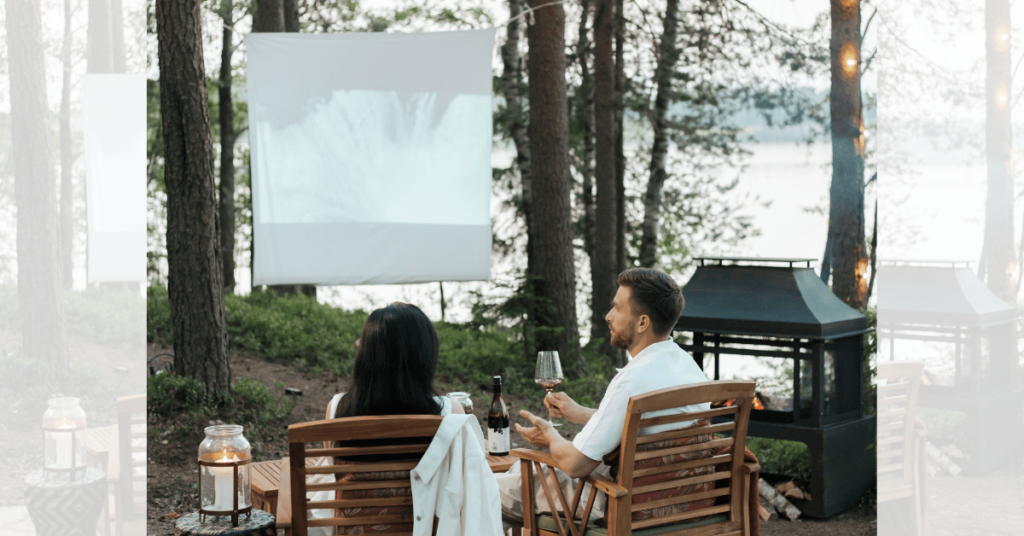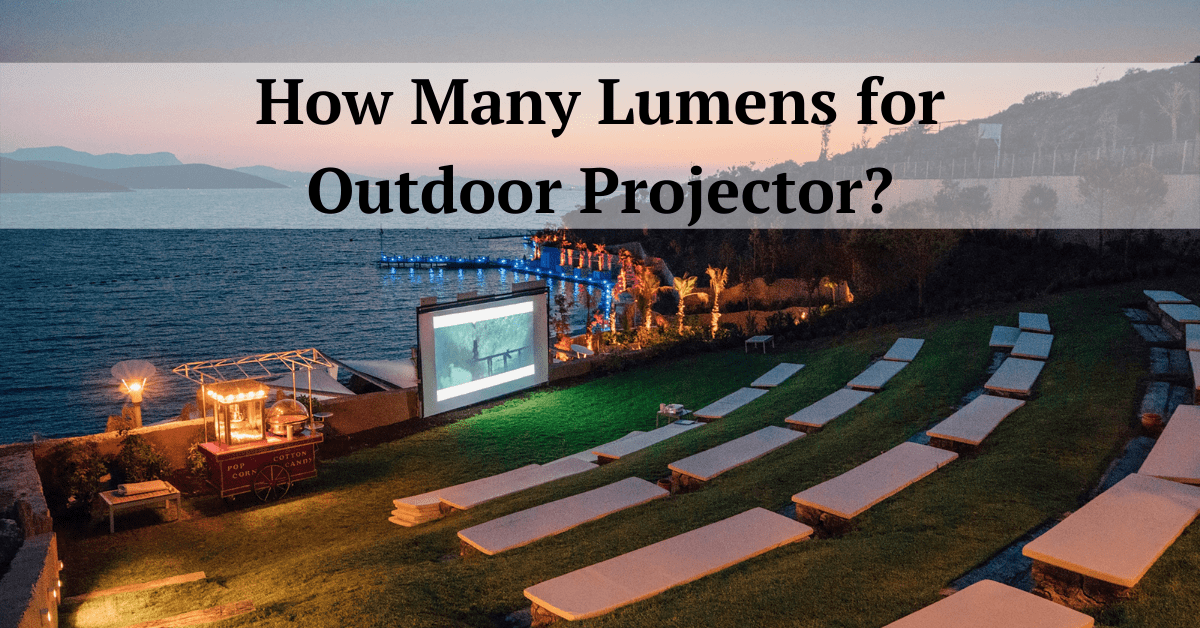Last Updated on July 12, 2024 by Admin
Watching movies indoors is one thing, but enjoying a film outdoors while taking in the fresh air and natural surroundings is a completely unique experience. However, Selecting the right projector for outdoor use involves several critical factors, with lumens being the most important one. The Lumen rating determines how well it can project outdoors. So, if you’re planning to use your projector during the day, figuring out how many lumens for outdoor projector can prevent washed-out visuals.
When using a projector outdoors, lumens (or ANSI lumens) are crucial, but they are not the sole factor to consider. Other aspects such as ambient light, screen type, screen size, throw distance, and more can significantly impact the overall output.
In this comprehensive guide, we will cover all the factors and lumen ratings necessary for using your projector outdoors. Additionally, we will also provide tips to counter the sunlight without the need to purchase a Projector with the highest lumens.
Before we begin, we recommend reading about “What is Lumens” and “What is ANSI Lumens” to grasp their differences and understand their crucial role in selecting the right projector.
Page Contents
Why Lumens Matter for Outdoor Projectors?
When setting up a projector, numerous factors must be considered to acquire satisfactory output. However, the primary factor to focus on is lumens (or ANSI lumens), especially when planning to use a projector outdoors.
Lumens measure the amount of light emitted by a light source (in this case, Projectors). Therefore, in the context of projectors, a higher lumen rating means a brighter image.
However, it’s not advisable to simply choose the projector with the highest lumens available. For instance, the Barco DP2K-32B digital cinema projector boasts an impressive brightness of 43,000 lumens but comes with a hefty price tag. Therefore, it’s essential to select a projector that meets our requirements while also being budget-friendly.
Unlike indoor environments, where ambient light can be controlled, outdoor settings introduce a range of factors to consider, particularly when mitigating the intense sunlight, which emits approximately 36 thousand trillion trillion lumens.
First, we need to understand the various factors that impact lumen requirements, and then determine the appropriate lumen rating needed. Finally, we will be able to choose the projector that best suits our environment and specific use.
Also check out the difference between TV Vs Projector.
Factors to Consider for Outdoor Projectors
For a comprehensive guide on setting up your outdoor projector, including factors such as screen type, placement, and sound setup, check out our detailed article on Factors for Outdoor Projector Setup
Here we will briefly explain the factors that affect lumen requirements.
- Ambient Light
- Screen Size
- Throw Distance
- Content-Type
1. Ambient Light:
When determining how many lumens for outdoor projector, ambient light plays a significant role in deciding the brightness needed to maintain visibility and picture quality. The presence of Natural sunlight can wash out Projector images. Higher Lumens Projector can help combat the ambient light if you are planning to use the projector outside during the day.
How Many Lumens?
- For daytime use, choose a projector with a higher lumen rating of at least 5,000 lumens.
- For nighttime use, a projector with 2,500 to 3,000 lumens can be sufficient if there is minimal ambient light.
2. Screen Size:
You might wonder how screen size affects projector lumens, but it actually makes a significant difference. When choosing outdoor projector lumens, we need to consider screen size and throw distance as well. A larger screen requires the projector to distribute light over a wider area, while a smaller screen concentrates light in a smaller area.
How Many Lumens?
- For screens up to 100 inches in size, fewer lumens are needed.
- For screens 150 inches and larger, higher lumens are required.
Sometimes, the Types of Projector Screens also matters when projecting outside. Check out all the projector screen types and see which one is suitable for you by clicking on the link above.
3. Throw Distance:
The Throw Distance is the distance between the Projector and the Screen. When the screen is farther away, the projector’s light must travel a greater distance, increasing the potential for dispersion and interference from ambient light along the way. In contrast, positioning the projector closer to the screen minimizes such interference, ensuring clearer projection.
You may explore further the distinction betweenUltra Short Throw vs Short Throw vs Long Throw Projectors
How Many Lumens?
- For short throw distances (less than 10 feet), fewer lumens are required.
- For long throw distances (over 20 feet), higher lumens are necessary.
4. Content-Type:
It might be surprising, but the content you intend to project also impacts the required lumens for an outdoor projector.
How Many Lumens?
- Bright and colorful animated content features vibrant colors, requiring fewer lumens when projecting outdoors.
- Conversely, dark, low-light videos shot at night require higher lumens to preserve image clarity and brightness.

How many Lumens for Outdoor Projector:
Here’s a comprehensive breakdown of recommended lumen ratings tailored for various outdoor scenarios, exclusively available on BestOfProjectors.com.
- For instance, in low ambient light conditions with a small screen upto 100 inches with a short throw Projector, which is projecting bright content in the evening would require approximately 2000 to 3000 lumens for a satisfactory viewing experience.
- Similarly, a long throw projector projecting bright content on a large screen of 150 inches, during high ambient light conditions in the daytime would require at least 6000 Lumens.
- Similarly, Moderate Ambient Light + Medium Screen + Short Throw + Bright Content -> 4000 to 5000 Lumens
- Low Ambient Light + Large Screen + Long Throw + Dull Content -> 4000 Lumens
- Moderate Ambient Light + Small Screen + Tensioned Cloth + Dull Content -> 3000 to 4000 Lumens
Here is a comprehensive table to assist you with all the combinations of factors that determine the lumens required for outdoor projection.

Practical Tips for Outdoor Projector Use:
To maximize your outdoor projector experience, it’s essential to apply the factors and tips detailed in our article “Factors to Consider to Setup Projector Outdoors“
To Explain briefly, follow these points
- Place the projector and projector screen in a shaded area to minimize direct sunlight exposure.
- Angle the screen to avoid direct sunlight falling on it.
- Consider using a high-gain screen to enhance light reflection towards the audience. Using a high-gain screen can optimize the effectiveness of lumens for outdoor projector viewing.
- If possible, avoid using the projector on sunny days and plan outdoor usage after sunset for best viewing conditions.
- Select a projector with sufficient lumens to combat daylight brightness effectively.

Frequently Asked Questions:
How many lumens for outdoor projector at night?
For nighttime use with minimal ambient light, the required lumens for outdoor projector depend on screen size and content type. Small screens (up to 100 inches) need 2000-3000 lumens, medium screens (100-150 inches) require 3000-4000 lumens, and large screens (150 inches and above) often need 4000+ lumens, especially for bright content. These recommendations ensure a clear, bright image in low-light outdoor settings.
How many lumens for outdoor projector daytime?
For daytime use with high ambient light, such as direct sunlight or bright environments, the required lumens for outdoor projectors depend on screen size. Small screens (up to 100 inches) need 4000-5000 lumens, medium screens (100-150 inches) require 5000-6000 lumens, and large screens (150 inches and above) often need 6000+ lumens. These higher lumen ratings ensure visibility and clarity in bright outdoor settings.
How many ANSI Lumens for Outdoor Projector?
For an outdoor projector, 5,000 ANSI lumens are recommended for daytime use to ensure a clear image in bright conditions. At night, with minimal ambient light, 2,500 to 3,000 ANSI lumens are usually sufficient. For larger screens or challenging conditions, consider higher ANSI lumens to maintain image quality.
You can read a few tips on How to Use a Projector Outside During the Day?

Final Words on Outdoor Projector:
Watching movies indoors offers one experience, but enjoying them outdoors in fresh air and natural surroundings creates a unique ambiance. However, choosing the right projector for outdoor use involves several critical factors, with lumens being the main factor.
The lumen rating defines how effectively a projector can perform outdoors, particularly crucial for combating daylight and maintaining image clarity. Understanding these factors helps determine the optimal lumen requirement, ensuring a vibrant and visible projection in various outdoor conditions. To ensure image clarity and brightness, calculate the required lumens for outdoor projector based on specific viewing conditions.
Also checkout some of the Best Outdoor Projector Under 300 Dollars, for budget users.
By considering ambient light, screen type, size, throw distance, and content type, you can tailor your projector choice to match your specific outdoor setting and viewing preferences. Refer to the table above to find the right projector for enjoying your outdoor show.
If you found this guide helpful, please share it with your friends and family who might also be interested in setting up their own outdoor projector. Sharing this article can help others make informed decisions and enhance their outdoor movie-watching experience. Plus, your support encourages us to continue providing valuable content.

